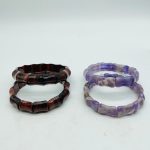In the realm of gemstones, purple stands out as a captivating color that exudes mystery, royalty, and creativity. This enigmatic shade adorns a select few gemstones, each boasting its own unique characteristics and captivating beauty. In this comprehensive guide, we delve into the world of rare purple gemstones, uncovering their allure, sources, and potential applications.

Amethyst: The Crown Jewel of Purple
Amethyst, the most well-known purple gemstone, is a variety of quartz that owes its characteristic hue to trace amounts of iron impurities. Ranging from delicate lavenders to deep indigos, amethyst has long been prized for its beauty and calming properties.
- Sources: Brazil, Uruguay, Zambia, Russia
- Hardness: 7 on the Mohs scale
- Origin: Ancient Greek, meaning “not intoxicated,” believed to counteract drunkenness
Tanzanite: A Serendipitous Discovery
Tanzanite, a relatively recent discovery, is a rare gemstone that has captured the imagination with its intense violet-blue color. Found exclusively in the Merelani Hills of Tanzania, this vibrant gem exhibits strong dichroism, showcasing different colors from different angles.
- Sources: Merelani Hills, Tanzania
- Hardness: 6.5 on the Mohs scale
- Discovery: 1967, by Manuel de Souza, a prospector from Portugal
Rubellite: A Deep Purple Passion
Rubellite, a type of tourmaline, emanates a captivating deep purple hue that rivals the intensity of rubies. Its color is attributed to the presence of manganese and iron. Rubellite is a popular choice for jewelry, where its vibrant shade adds a touch of sophistication and allure.
- Sources: Brazil, Madagascar, Afghanistan, Nigeria
- Hardness: 7 to 7.5 on the Mohs scale
- Origin: Latin, “rubellus,” meaning “reddish”
Pain Points and Motivations in the Purple Gemstone Market
The allure of rare purple gemstones stems from their scarcity, captivating hues, and historical significance. However, pain points in the market include:
- Limited supply and high demand, resulting in fluctuating prices.
- Concerns about ethical sourcing and environmental impact.
- Lack of standardized grading criteria, making it challenging to assess quality.
These challenges have motivated industry players to:
- Explore alternative sources and develop sustainable mining practices.
- Invest in research and development to enhance gemstone quality.
- Establish industry-wide grading standards to ensure transparency and consistency.
Potential Applications for Purple Gemstones
Beyond jewelry, the alluring beauty of purple gemstones sparks inspiration for innovative applications:
- Wellness and spirituality: Amethyst is believed to promote tranquility, reduce stress, and enhance spiritual awareness.
- High-tech materials: Tanzanite has unique optical properties that make it promising for use in laser technology and medical imaging.
- Art and design: Rubellite’s vibrant hue has captured the attention of artists and designers, who incorporate it into sculptures, paintings, and textiles.
- “Purpletechture”: Architects and interior designers are experimenting with incorporating purple gemstones into building facades and interior decor, creating captivating and vibrant spaces.
Tips and Tricks for Choosing the Perfect Purple Gemstone
- Consider the occasion: Amethyst is suitable for everyday wear, while tanzanite and rubellite are better suited for special occasions.
- Match the color to your skin tone: Warmer skin tones complement amethyst and rubellite, while cooler tones look better with tanzanite.
- Inspect the clarity: Choose gemstones with minimal inclusions for enhanced brilliance.
- Get it certified: Obtain a certificate of authenticity from a reputable gemological laboratory to ensure the gemstone’s natural origin and quality.
FAQs: Unraveling the Mysteries of Purple Gemstones
1. What is the most expensive purple gemstone?
Tanzanite is generally the most expensive purple gemstone due to its rarity and intense color.
2. How do you clean purple gemstones?
Use a soft cloth and mild dish soap to gently clean purple gemstones. Avoid using harsh chemicals or ultrasonic cleaners.
3. Are all purple gemstones natural?
While most purple gemstones occur naturally, some may be treated to enhance their color or clarity. It is important to consult with a reputable jeweler to determine the authenticity and treatment status of your gemstone.
4. What is the difference between amethyst and tanzanite?
Amethyst is a variety of quartz, while tanzanite is a variety of zoisite. Amethyst is typically lighter in color and more affordable than tanzanite.
5. Is it safe to wear purple gemstones every day?
Yes, it is generally safe to wear purple gemstones every day. However, it is advisable to remove them before engaging in strenuous activities to prevent damage.
6. How can I tell the difference between a genuine and a fake purple gemstone?
Genuine purple gemstones typically have a natural shine and even color. Fake gemstones may appear dull or have an artificial-looking color. Consult with a gemologist for professional identification.
7. What are the healing properties of purple gemstones?
Amethyst is believed to have calming and stress-reducing properties, while tanzanite is said to promote creativity and spiritual growth. However, these claims are subjective and based on personal beliefs.
8. Do purple gemstones have any cultural significance?
Purple gemstones have been associated with royalty, spirituality, and wealth in many cultures throughout history. For example, amethyst was once believed to protect against drunkenness, while tanzanite is considered a symbol of hope and prosperity in some African cultures.




























